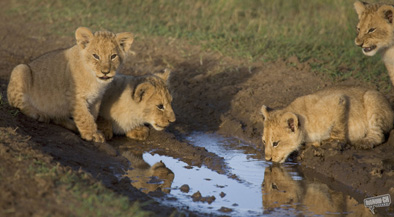Movie Review: African Cats
By Matthew Huntley
April 27, 2011
BoxOfficeProphets.com

The film documents two groups of cat families in Kenya’s vast and wild savanna, which is divided by a long and winding river. On one side is a pack of lionesses and their cubs. Layla is the oldest and most experienced of the group. Despite her frail condition, she continues to hunt and watch over her daughter, Mara. The father to all the cubs and chief protector of the pride is Fang, who broke his tooth during a fight with another animal, though he walks around as if it doesn’t really hurt. In a remarkable scene, he forces a crocodile to back down, which seems relatively easy compared to maintaining his role as king from a rival group of lions, led by Kali and his two sons.
On the other side of the river is a cheetah named Sita, a single mother with five newborns. Alert and determined, she keeps a watchful eye on her babies and fends off enemies like hyenas and male cheetahs, and there’s even a point where she outwits a lion by diverting his attention away from her cubs.
This and several other scenes sum up the movie’s theme - that all animals, be it a lion, a cheetah or an elephant, will do whatever it takes to protect their offspring to ensure the survival of their species. When we see the instincts of these animals kick in, a bond forms between us and them, and though it may sound strange to say so, we immediately identify with them because they, like us, inherently know the importance of family. We don’t love and protect our young because we have to, or even because we necessarily want to, but because there’s something inside us telling us it has to be done, that it’s nature, and it’s impossible to go against nature.
That’s what I took from the movie, which has been directed by Keith Scholey and Alastair Fothergill. They want us to empathize with these animals so we’re humbled into recognizing we’re not the only creatures alive on this planet. There are other animals like us with the same instincts and love for their own kind.
The footage in African Cats is striking and speaks for itself, even though we feel like we’ve seen it in other films of this type. The narration is simple and reads at the level of a children’s storybook, which is appropriate, I suppose, since kids are likely the primary audience and the movie’s intention is to educate viewers.
What’s interesting is this film was distributed by Disney, who also made The Lion King, and if there’s one thing African Cats does, it demystifies movies with talking animals. It reminds us that nature is not always cute and friendly; it can also be fierce, dangerous and tends to only be survived by the strong and enduring. Perhaps our children should be watching movies like African Cats before The Lion King, just to let them know, early on, that nature is real and powerful and that it deserves our attention, respect and care.